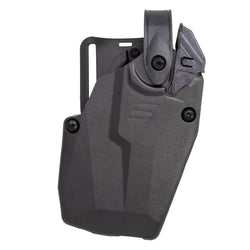Defensive ammunitions come in a number of configurations, ranging from monolithic solid rounds to non-expanding yawing projectiles. But the most common defense rounds are hollow points. Like those other projectiles, a results may vary sticker should be slapped on every demonstration of hollow point effectiveness.
Hollow point bullets do their work through projectile flattening and expansion on impact. But there is a relatively narrow set of criteria that have to be fulfilled for them to work as advertised. Some factors cause hollow points to expand as advertised, factors that cause overexpansion, and factors that prevent hollow point expansion entirely.
With a few decades of ballistic testing, game hunting, and primary source research under my belt, I have been able to come up with some general phenomena that may be a useful rule of thumb. Here is why hollow points expand, why they don’t, and what you might do to ensure your ammunition of choice works.
Hollow Point Mechanics
Hollow point bullets vary in exact material composition, but the concept is essentially the same, no matter what brand you buy. Whether you are using an all-lead bullet, a copper-jacketed bonded round with a lead core, or a lead-free alternative, hollow points consist of a hollow cavity in the nose and dividing lines around it.
At a given velocity, a hollow point round’s cavity is pressurized and tormented by fluid and bone. The cavity fails under pressure, helped by the fault lines around it, causing the nose to peel backwards and expand. But this action happens under the assumption that a given bullet is driven at a given velocity range.
Bullet construction is another, potentially unseen factor, as you go about making your selection.
Bullet Selection and Construction
Just by looking at a loaded cartridge, it is difficult to tell whether a bullet is built in a way that is tough enough to work correctly without being too tough.
Some bonded hollow points, particularly those with smaller cavities and shallow shivs, deliver little expansion on a point target but excel at penetrating intermediate barriers while still having an expansive effect on a target behind it. What might work best in a duty scenario may not be so in everyday life.
On the other hand, particularly deep cavities can invite jacket separation and the loss of petals. With less weight, there is less mass and momentum to penetrate.

There are also other considerations to weigh, particularly when you veer off the jacketed hollow point realm. Light copper-based rounds can throw fliers or not hit where your sights are regulated with standard ammunition. Pure lead bullets can leave too much of themselves behind by leading the barrel, which brings down accuracy, particularly if you are lax on bore cleaning.
FBI Guard Rails: Reguard or Disregard?
In the aftermath of the 1986 Miami Dade Shootout, the FBI went into overdrive to develop a pedagogy to evaluate duty ammunition. Since then, the FBI has come up with a set of criteria using comparative ballistic gelatin tests that correlate with effectiveness in real encounters.
That criterion has since been a standard of measure for self-defense ammunition from the three-letter agencies all the way down to hobbyists. Twelve inches of penetration is deemed to be the minimum acceptable, as less penetration at some shot angles may not be enough to penetrate vital organs. Eighteen inches is the outer limit, where additional penetration would be wasted energy.
As manufacturers jumped at the chance to meet these criteria, advertising came into play. Penetration had to be balanced with expansion, and firms like Speer and Winchester marketed rounds like their Gold Dot and Defender ammunition with advertised expansion of 1.5x original diameter. That standard has since become the basis for hollow-point performance.

Taken together, these criteria provide a good baseline for evaluating ammunition. This is particularly true with duty-sized handguns.
But does that mean a hollow point that falls just short of the criteria cannot be effective? Probably not. There is even less said about using existing ammunition in smaller, shorter-barreled handguns and increasingly popular pistol-caliber carbines.
Even the best hollow point designs can fail to deliver under the wrong circumstances. Clothing and intermediate barriers can get in the way, and the projectiles themselves are sensitive to how fast or how slow you push them. Velocity is also impossible to ignore.
Not Far Enough: Failures to Expand
Hollow points that fail to expand can still be very effective, but there are no expanding petals to slow the round down or nick vital systems to get an incapacitating hit. The end result is a more expensive version of a full metal jacket bullet that can zip straight through the target. Failures to expand are a result of either low velocity or barrier penetration, or a combination of the two.

Smaller-caliber pocket pistols ranging from .22 LR to .380 ACP with velocities in the 700-900 feet per second range often lack the speed to open up hollow point designs meant for higher velocity cartridges. Even conventional service cartridges can have less than stellar performance when neutered by a short barrel or with less expensive ammunition like Winchester White Box and Federal American Eagle.

Clothing and other barriers can also clog the hollow point cavity and prevent it from expanding. Manufacturers have tried with varying degrees of success to mitigate the issue by expanding the hollow point cavity. The Hornady FTX projectile is a different take. Hornady took the approach of inserting a polymer tip into the hollow point cavity so that it acts as a wedge on impact and prevents clogging.
Going Too Far: Hollow Point Over Expansion
Hollow point failure usually begins and ends with failures to expand. But it is possible for a hollow point to function too well due to overexpansion. Some hollow point loads are geared toward shorter-barreled handguns, but most are for duty-sized handguns. In either case, a sub-5-inch barrel is typical. But if you put the same ammunition in a long-slide handgun or even a pistol caliber carbine, the higher velocities can cause the petals to peel more aggressively.

The fired bullet expands handsomely at the cost of penetration. Even in smaller calibers like .380 ACP, rounds like the Hornady Critical Defense, which provide a good balance of penetration and expansion from short-barreled pocket pistols, woefully underpenetrate when put into a full-sized handgun.
The solution is to opt for a round with a narrower cavity, like any number of rounds using the Hornady XTP bullet. Budget loads can also be more effective in longer-barreled handguns, where they are marginal for conventional models. The need for special loads optimized for PCCs has resulted in a small but growing market of carbine loads like the new Speer Gold Dot Carbine lineup.
Fear Naught: We Have the Technology
In the early days of hollow points, effectiveness was judged the hard way in real shootings. Testing methodologies and the ammunitions themselves have evolved over the decades, and information on most loads is readily available and comparable.
If you are considering a full-sized or compact handgun for duty, concealed carry, or home protection, it is easy to find a load that will perform well and avoid those with more hype than hitting power. But there will be times when a poor choice can rise to the occasion, and the best ammunition falls short. Depending on such factors as caliber, velocity, and barriers between your round and the target, hollow points can perform and underperform. For those outlying cases, selection should be more judicious.
But above all else, no matter what round you choose, the reliability of the ammunition in your chosen firearm is more important than flowery bullets and gel tests.









